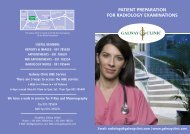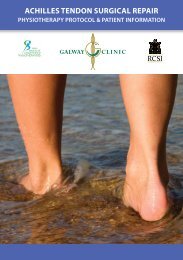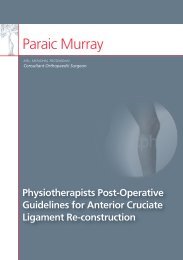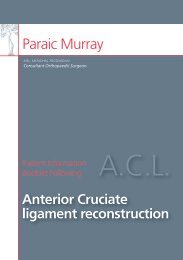ROTATOR CUFF REPAIR - Galway Clinic
ROTATOR CUFF REPAIR - Galway Clinic
ROTATOR CUFF REPAIR - Galway Clinic
You also want an ePaper? Increase the reach of your titles
YUMPU automatically turns print PDFs into web optimized ePapers that Google loves.
<strong>ROTATOR</strong> <strong>CUFF</strong> <strong>REPAIR</strong><br />
POST OPERATIVE PHYSIOTHERAPY PROTOCOL
Welcome to the GalWay clinic<br />
This information booklet has been designed to provide guidelines on the physiotherapy<br />
rehabilitation following surgical repair of the rotator cuff shoulder muscles.<br />
You may further your reading by using the references and the links provided at the end of this<br />
booklet and discuss any queries with your physiotherapist and/or orthopaedic surgeon.<br />
the rotator cuff<br />
The rotator cuff is comprised of four muscles. These individual muscles combine at the shoulder<br />
joint to form a thick “cuff” over the joint.<br />
The shoulder is a ball and socket joint with quite a shallow socket, unlike the hip joint which has a<br />
deep socket. It therefore heavily depends on the rotator cuff muscle for stability as they serve to<br />
control the position of the ball component or humeral head in the socket or cavity.<br />
The Rotator Cuff Muscles:<br />
1. Supraspinatous<br />
2. Infraspinatous<br />
3. Teres Minor<br />
4. Subscapularis<br />
Rotator cuff muscles of shoulder joint, from behind<br />
2<br />
Rotator cuff tendons, shoulder attachment
classification of rotator cuff injuries<br />
Rotator Cuff<br />
Tear<br />
Rotator Cuff Injuries can be classified into two categories<br />
1. Tears of the tendons<br />
2. Inflammation of the structures in the joint<br />
Supraspinatous and infraspinatous are the most commonly injured rotator cuff muscles. Sports which involve<br />
at lot of shoulder joint rotation put these muscles under a lot of stress e.g. bowling in cricket and swimming.<br />
An acute tear can happen following a fall onto an outstretched hand or following a powerful throw.<br />
As a result of a severe tear, outward arm movement may not be possible.<br />
A chronic tear usually occurs as a result of entrapment or impingement where the tendon rubs against the<br />
overlying bone. The rotator cuff tendons are impinged as they pass through the space between the shoulder<br />
blade, the outer collar bone joint above and the upper arm bone below.<br />
Mechanical irritation can occur which causes swelling and damage to the tendons and inflammation of<br />
these structures.<br />
Depending on the degree of tear diagnosed both clinically and through appropriate scanning, repair to the<br />
tear will be performed by your orthopaedic surgeon.<br />
3
PhysiotheraPy Guidelines for Post surGery<br />
rotator cuff tear rehabilitation<br />
The following recommendations are for chartered Physiotherapists treating patients after rotator cuff tendon<br />
repair.<br />
The better you are informed the more likely you will recover and be able to prevent recurrence of your injury.<br />
Part of the role of your chartered physiotherapist will be to translate the following guidelines into a<br />
straightforward format for you to gain from.<br />
Protocol selection will be determined not just by the size of the tear, but also the shape of the tear,<br />
strength of repair and general tissue and joint condition.<br />
It is important to liaise with the orthopaedic surgeon or the <strong>Galway</strong> <strong>Clinic</strong> physiotherapy team for<br />
any specific post operative instructions.<br />
GoAl: Gradual increase in RoM<br />
1. Do not force or over stretch. Check for exact tendon repair site and avoid over tensioning e.g.<br />
Supraspinatus - avoid full passive internal rotation and adduction.<br />
Subscapularis - avoid full passive external rotation and abduction<br />
2. No over tensioning before 6 weeks for minor tears and before 8 weeks for larger tears.<br />
3. Minor < 1 cm tear:<br />
May start active assisted movements at 2-4 weeks<br />
4. Medium ~ 1-3 cm and Major >3 cm:<br />
May start active assisted movements at 6 weeks. (Please confirm with consultant).<br />
Shoulder immobiliser (shoulder abduction brace) may be fitted for 3-6 weeks.<br />
Check tear size for duration of wear. To be worn day and night once fitted.<br />
1. Minor tears may be immobilised for three weeks<br />
2. Medium and Major tears for six weeks<br />
4
The shoulder abduction brace should fit snuggly<br />
1. The cushion component is placed in situ and secured with appropriate strapping.<br />
2. The body strap secures the cushion<br />
3. The shoulder strap secures the arm position.<br />
4. Correct fitting is reinforced.<br />
5. Any queries should be dealt with by your Chartered Physiotherapist.<br />
1 - 6 Weeks<br />
1. Minor tears immobilised x 3 weeks<br />
2. Fit shoulder immobiliser as stipulated and remove<br />
after the appropriate time<br />
3. Elbow and hand exercises<br />
4. Teach postural awareness<br />
5. Pendulum exercises<br />
6. Pulleys<br />
7. Commence passive flexion, abduction and external<br />
rotation of the shoulder as per consultant’s instructions<br />
8. Passive flexion in supine with stick (125˚ - 145˚)<br />
9. Passive external rotation in supine with stick<br />
10. May increase abduction to 65˚<br />
11. Scapular setting in sitting<br />
5
6 - 8 Weeks<br />
1. Medium and majors tears immobilised x 6 weeks<br />
2. Passive flexion in standing with stick<br />
3. Passive extension in standing with stick<br />
4. Assisted active to active flexion in supine with elbow flexion, progress to elbow extension -<br />
add weight as tolerated<br />
5. Shoulder shrugs - add weight as tolerated<br />
6. Scapular stability exercises<br />
7. Scapula setting in prone (0° abduction)<br />
8. Isometric internal / external rotation strengthening as comfort allows<br />
6
8 - 10 Weeks<br />
GoAl: Full non-painful RoM<br />
1. Active flexion in standing - add weight as tolerated<br />
2. Active horizontal flexion/abduction in standing - add weight as tolerated<br />
3. Scapula retraction with shoulder extension in prone - add weight as tolerated<br />
4. Horizontal abduction with external rotation in prone- add weight as tolerated<br />
5. Push ups on wall<br />
6. Light theraband (with scapular setting)<br />
7. Weight bearing exercises (on all 4’s with scapular stability)<br />
7
10 - 12 Weeks<br />
GoAlS:<br />
• Maintain full non-painful ROM<br />
• Improve strength and<br />
• Improve neuromuscular control<br />
1. Posterior capsule stretches<br />
2. Hand behind back stretches<br />
3. Increase theraband resistance as tolerated<br />
4. Press ups from chair if tolerated<br />
5. Push ups from knees if tolerated<br />
6. Proprioception exercise with Swiss ball<br />
8
ProGressions<br />
1. Increase Theraband resistance and angle of movement (e.g. IR/ER at 90° abduction)<br />
2. Attention needs to be given to strengthening and setting the scapula<br />
3. Continue strength training of Rotator cuff, include Latissimus dorsi and Biceps<br />
brachii muscles<br />
4. General gym strengthening (military press ups, shoulder bench press, lat pull downs,<br />
biceps/triceps exercises)<br />
21-26 Weeks<br />
An isokinetic test may be performed in the <strong>Galway</strong> <strong>Clinic</strong> to help clarify the time to return to<br />
sporting or manual activities.<br />
Isokinetic Testing is a computerised and therefore objective measurement of muscle strength and<br />
endurance.<br />
It will help us assess and therefore address the presence of any potential problems associated with<br />
muscle strength, muscle imbalance, flexibility, posture and patterns of movement that may delay<br />
return to sporting or manual activity.<br />
Isokinetic training is also a useful tool in end stage shoulder rehabilitation as speeds may be set<br />
to reproduce the high speeds that are produced during most upper limb sports, e.g. tennis, golfing,<br />
swimming etc.<br />
9
General Guidelines<br />
• AcTIvITIeS oF dAIly lIvInG - Do not force or stretch the repair before 8 weeks<br />
(6 weeks for minors)<br />
• dRIvInG - Patients are in a sling for 6 weeks (except minor tears) and should not drive for<br />
6-8 weeks. Your consultant will advise you when you can drive.<br />
• lIFTInG - No heavy lifting for approximately 3 months after the procedure, your<br />
physiotherapist will advise you on the appropriate weights to lift.<br />
• ReTuRn To woRk - Depends on your occupation. Minor tears with sedentary jobs may<br />
return in 6 weeks. Major tears may take 12 weeks. Manual workers should be guided by their<br />
orthopaedic consultant<br />
• SwIMMInG - Breast stroke<br />
Minor and Medium repairs - 6 weeks; Major repairs - 12 weeks<br />
• GolF - 3 months<br />
10
eferences<br />
Compiled from data bases courtesy of<br />
1. The Irish Society of Chartered Physiotherapists (ISCP)<br />
2. The UK Chartered Society of Physiotherapy (CSP).<br />
3. Brukner P, Khan K (2009), <strong>Clinic</strong>al Sports Medicine, Third Revised Edition,<br />
McGraw-Hill Sports Medicine<br />
Other useful sites<br />
- National Institute of <strong>Clinic</strong>al Excellence (NICE)<br />
http://www.nice.org.uk<br />
- Best Treatments (British medical journal)<br />
http://www.besttreatments.co.uk/btuk/home.html<br />
Glossary<br />
Flexion Forward movement of the joint<br />
extension Backward movement of the joint<br />
RoM Range Of Motion<br />
Abduction (Abd) Sideward movement of the joint<br />
Adduction (Add) Movement of the joint across body<br />
Passive Complete assistance through the joint movement<br />
Assisted Active Assistance offered through out the movement of the joint.<br />
external Rotation (eR) Rotating the joint outwards<br />
Internal Rotation (IR) Rotating the joint inwards<br />
Scapular Setting Setting the shoulder blades into a centred position<br />
Isometric Strengthening the muscle in a static manner<br />
Prone To lie on your front<br />
Theraband Resistance band in different colours to strengthen the joint muscles<br />
11
The <strong>Galway</strong> <strong>Clinic</strong><br />
orthoPaedic & sPorts chartered PhysiotheraPy<br />
Doughiska, Co. <strong>Galway</strong>, Ireland<br />
Phone: + 353 (0)91 785 450/457 Fax: + 353 (0)91 785 453 E-Mail: physio@galwayclinic.com<br />
www.galwayclinic.com






